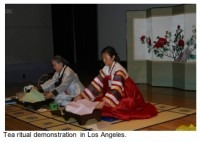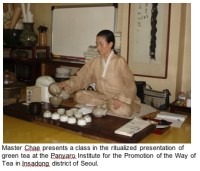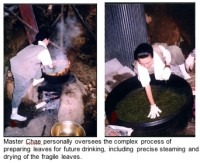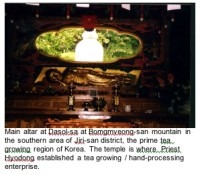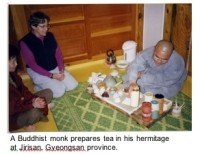Entering the Way of Tea: The “Dewy Path” to the Tea House
Originally Published in Parabola (Fall 2009)
|
Since the Dewy Path
Is a way that lies outside,
This most impure world
Shall we not, on entering it,
Cleanse our hearts from earthly
mire?
--- Sen no Rikyu
|
|
“Please come for tea.”
My invitation to attend a chaji 茶事, a
formal Japanese tea gathering, offered a poem by the venerable Bashô (1644 –
1694):
|
Haru nare ya
|
It has become spring!
|
|
Na-mo-naki-yama no
|
Even on the nameless mountains
|
|
Usu-gasumi!
|
A thin mist!
|
By all accounts, spring, indeed, had arrived! Blossoms were
appearing on the plum trees; butterflies were celebrating near rape flowers;
earthworms were weaving in and out of bright green new shoots of grasses
encouraged forth by the blessings of rain. All proceeding in due time, at a
natural pace. The process of chanoyu
(茶の湯) preparing hot water for tea, another
name for the ritual, was very appropriate for such an occasion.
Practitioners of “the Way of Tea” (sado 茶道) know
that the guest (kyaku 客) arrives in
the same way, in due time and with a clear, natural intention: to create a
singular union of mind-to-mind, heart-to-heart with the host (teishu 亭主)and fellow
guests. Together we would engage in this once-in-a-lifetime meeting (ichi go ichi e 一期一会).
The Hebrew prayer commonly known as the “Shehechiyanu”, fits the moment perfectly:
 Baruch ata Hashem, Baruch ata Hashem,
|
Blessed are You,
|
|
Eloheinu Melech Haolam
|
Master of the Universe
|
|
Shechehiyanu
|
Who has kept us alive,
|
|
V’ki'imanu
|
And sustained us,
|
|
V’higiyanu lazman hazeh
|
And enabled us to reach this moment.
|
The beauty and complexity of the tea event, with its ritualized
preparation of matcha (抹茶), the
powdered form of the green leaf of camelia sinensis, was codified and inspired in Japan by
Zen Buddhists, early in the Muromachi Period. The taste of tea and Zen have
been said to be equals in matters of attainment of nothingness, (mu 無) and emptiness (kû 空). Our modern practice has come to us through
an unbroken lineage of over 16
generations of tea masters, of whom Sen no Rikyu (1522 – 1591), is considered to be our greatest ancestor.
Chanoyu
captivated the imaginations of egomaniacal warlords and their swashbuckling
samurai retainers, providing a moment of peace in the midst of battle, and
instilled a reasonable amount of refinement and upward social mobility. To be
the ultimate action hero of the time, a warrior needed to know how to prepare tea
for one’s “enemy” while seated together in a tiny, rustic, no-swords-allowed
hut with walls no thicker than a sheet of paper. In later years geisha training included performing the ritual for
clients.
Images abound of the host methodically and seemingly mysteriously
wiping precious utensils and scooping water from a sunken kettle barely visible
above the tatami mat floor, its steamy voice hissing, “matsukaze” (松風), the sound of “wind in the pines”. The quest of the guest is
less known. She is usually depicted
silently awaiting the tea sitting motionless, on her heels, hands resting in
her lap. But in fact, if she’s in the
tearoom, she would have
just traversed the path of
“The Great Way” and is
engaged in a liminal journey of rebirth.
Slowing it Down to Promote Social
Harmony, Appreciation
"Day and night, with the
monastic rules of the Zen temples as my guide ...
I unfolded the world of the Pure Land
in the locus of the roji..."
-- Sen no Rikyu "Metsugo"
section of
Namporoku
Today, while the world is smaller and the battlefields seeming
more distant, individuals of all backgrounds throughout the world find in chanoyu practice opportunities for purification and self-refinement. While contemporary
technology moves us at the speed of light and multi-tasking is considered a
valuable capacity, there are no “short cuts” in chanoyu. We continue to aspire to attain Rikyu’s objectives:
to create a condition of tranquility (jaku 寂), then harmony (wa 和), respect (kei 敬) and purity (sei 清).
in
an ideal setting of repose, free from anxiety, where there is “no guest, no
host”,
our roles are nonetheless specifically defined along the lines of studied
procedures learned over many years of practice that foster the communitas we
seek
.
On the outside, all the bowing might be misconstrued as a duel of
humbleness, but in sado,
too low is too rude and professing great skills and utensils is nothing short
of vulgarity. The essence of this journey
is implied in the notion of
wabi, わび, a Japanese poetic “ideal that finds surpassing
beauty and deep significance in what is humble or commonplace and appears
natural or artless.”
Combined with the notion of
sabi, さび, withered
with age, the expanded concept conveys the sentiment of a life well-lived in
harmony with the laws of nature.
Along the “Dewy Path”
I
was one of a handful of invited guests who had arrived at the location. While
the journey is extremely personal, we needed to become a cohesive group. We
unanimously invited the respected chanoyu instructor among us to serve as the first guest (shokyaku 正客); she
would conduct the prescribed discourse with our host on our behalf.
Chanoyu begins in
the roji
(露地) the “dewy path” of the garden that leads
to the rustic tea hut (chashitsu 茶室).
The feeling is traveling along
a metaphorical riverside “mountain” path through a symbolic forest. According
to the monk Jakuan Sotaku of the Eastern Capital, “…
“ … ro 露
means “to be disclosed,” “to appear,” and ji, 地 ground,
refers to the heart and mind. Thus, the term actually means “to discloser
self-nature.” Eradicating all blind passions, one manifests one’s original
nature.”
The
roji is designed, constructed and
maintained as if it were indeed the path to Buddha’s Pure Land. Like the
Israelites fleeing bondage in Egypt in the mystical interpretation of the Exodus,
we would progress through a series of progressively
smaller and lower gates, our “narrow” places, leaving behind the dusty
defilement of the mundane world. Freed of all such encumbrances and purified,
we hope to be reborn by the end of this experience.
In
its earliest form the roji was an
empty space, neither planned nor conceived as a garden. It was void of
vegetation, resembling more the
barren “open space at a crossroads,” referred to in the third chapter (“Smile
and Parable”) of the Lotus Sutra.
Today
most rojis include
tightly-manicured, low, naturally placed foliage, such as moss, as well as
evergreen, bamboo and broad-leafed trees that one would find by a mountain path
running adjacent to a year-round creek. Our host’s roji included a “sleeve brushing” pine tree (sode-zuri
matsu 袖摺の松) near the path to enhance a feeling of being on a
narrow path in a dense forest. The garden sparkled as a result of his having
carefully sprinkled water with “refined discrimination” just before we arrived.
Passing
through the first gate, that of the outer garden, we reached a rustic roofed
waiting arbor (machiai 待合; the bench was covered in dark blue felt upon which
were straw cushions. The host was there and with a silent gesture he opened the small gate to the “inner”
garden, then turned and walked away to the tea hut.
The
roji footpath itself is a series
of elevated, uneven rocks (tobi-ishi, 飛) and occasional slate pavers naturally set into the
bare earth through grass and moss covered areas. The layout subtly coaxed us to
turn this way and that, providing views of the tiny garden from many vantages.
The sound of our shoes on the rocks gave the host a sense of our progress
toward the tea hut. The experience of walking on irregular ground immediately
made us mindful of our gross, physical body. Over the three-hour chaji experience, the reminders will become more subtle as
we become more attuned to the more spiritual aspects of our journey.
Here
and there, our host allowed a small cluster of freshly fallen leaves
appropriate for the seasonal, temporal nature of our reality. There were no
flowering tress or plants that would otherwise compromise the use of naturally
arranged flowers in the tea room itself. in a few feet, the roji path split, the wrong-of-way was indicated through the placement of a
“barrier-keeper” stone (sekimori-ishi, 関守石), a fist-sized rock tied with a black
straw chord placed in the middle of one of the stepping stones.
Purification of the Body and Mind
In
about a minute’s time, we reached the proverbial “river’s edge”, represented by
an informal patch of ferns shading the stooping basin rock (tsukubai 蹲踞). A signature elements of a roji,
the large, low rock had a natural
depression in the top into which fresh, cool water trickled from a system of
freshly-cut bright green and yellow bamboo “pipes”, flowing over into the river
stones below. Proceeding one by one, we each crouched down to perform the
purification ritual (misogi 禊) of rinsing hands and mouth, and thereby the mind,
using the bamboo dipper. A stone lantern (ishi-tuorou 石灯籠, another signature of a roji,
stood sentry nearby.
“His body cleansed, the guest passes
from one world to another and, with a sense of keen awareness increasing at
each step of the way, finally arrives at the teahouse, whose interior has
become less the realm of the connoisseur than a sacred space.”
Arriving
After
about 15 minutes since we first gathered, the small frame of the chashitsu around the corner, resembling the hermitage o a lone aesthete, was now apparent through the trees. The host
intentionally left the sliding hatch door of the guest’s entrance (nijiri-guchi 躙口) slightly ajar. The nijiri-guchi is about 26” high and 25” wide and is yet another
“narrow place” for the guests, regardless of rank, to traverse as equals: one
must duck inside and slide forward with the hands propelling the knees. In the
earliest days of chanoyu the nijiri-guchi was the entrance through the outer wall of the garden
– hut complex itself.
Negotiating
the large rocks needed to access the raised entrance, one by one, we removed our
shoes and made our way through the hatch, pulling one’s head and shoulders and
knees up into the space. The last guest slid the door shut, touching the wood
to the door frame with a “click” to indicate to the host that we were now
inside. inside the room, the host had hung a scroll in the raised alcove (tokonoma 床の間), “Kan. Nan Boku Tô-zai Katsu Ro Tsûzu”,
interpreted as “Barrier. South. North. East. West. Make your escape
anyway you can,” setting the mood for the remainder of the gathering.
Together At Last!
“[He] had left the burning house of
the three worlds, and dwells now in the pristine garden (byakuroji). To leave the roji and take one’s seat at chanoyu is the same as escaping the
afflicted world of desire and becoming a person without rank in this existence.
Therein lies true “unconditional freedom.”
-- Hounsai, Sen Soshitsu XV
(Daisosho, Genshitsu,
Retired Grand Master, Urasenke)
The full chanoyu, including the host’s serving a multi-course meal and sweets (and
not eating with the guests!), the laying of charcoal to heat the water and two preparations of
tea, took an additional three hours. It was a seamless “dance” of give and
take, engaging the Taoist paradigms of yin and yang, and the five elements
(earth, wind, fire, water and metal). Nothing was lacking in that tiny space.
After the final tea preparation utensils were inspected by the
guests and returned to the host, he requested our pardon for having made any
mistakes. Then we made a final exchange of bows and prepared to reenter the mundane world from which we came. At once
physically tired but spiritually renewed, we wriggled out of the nijiri-guchi, the last guest closing it with a “click”, signaling
to the host that the room was empty. The garden sparkled as it did earlier as
the host had lightly watered it anew. One by one, we walked back through the
“narrow places”, which seemed to be roomier than before. Closing the gates one
by one, we left the “Pure Land”. Bidding each other a safe return to our homes,
we went our separate ways.
If you do not see the Way, you do not
see it even as you walk on it.
When you walk the Way, it is not near,
it is not far.
If you are deluded, you are mountains
and rivers away from it.
***
A note from the author: I hope you enjoyed this article written for
Parabola, a nonprofit
journal. The original publication has many additional photographs. Please consider purchasing a copy of the magazine, (volume 35, no. 3) and
support this wonderful publication. (www.parabola.org). Thanks!
Several sources of kanji, Chinese characters used in Japanese language, were
used for this article, including
http://japanese-tea-ceremony.net/chashitsu.html\ , http://www.j-prep.com ,
http://en.wikipedia.org/ and http://www.aisf.or.jp/~jaanus/. While one cannot
fully acquire the skills and heart to practice chanoyu from any media, it is gratifying to have these
language tools to help me go deeper into what I have learned through direct
oral transmission of my dear sensei,
Sosei Matsumoto.
Kumakura, Isao, “Sen no Rikyu” in Tea in Japan:
Essays on the History of Chanoyu











